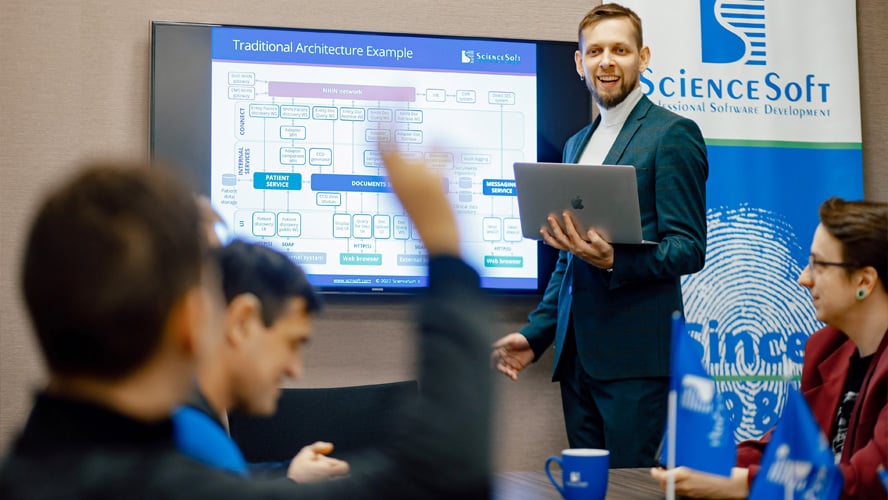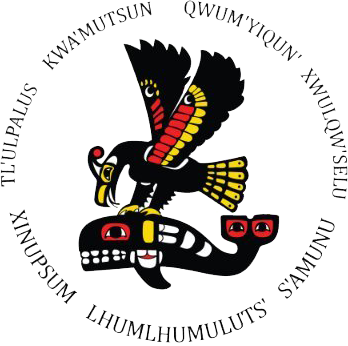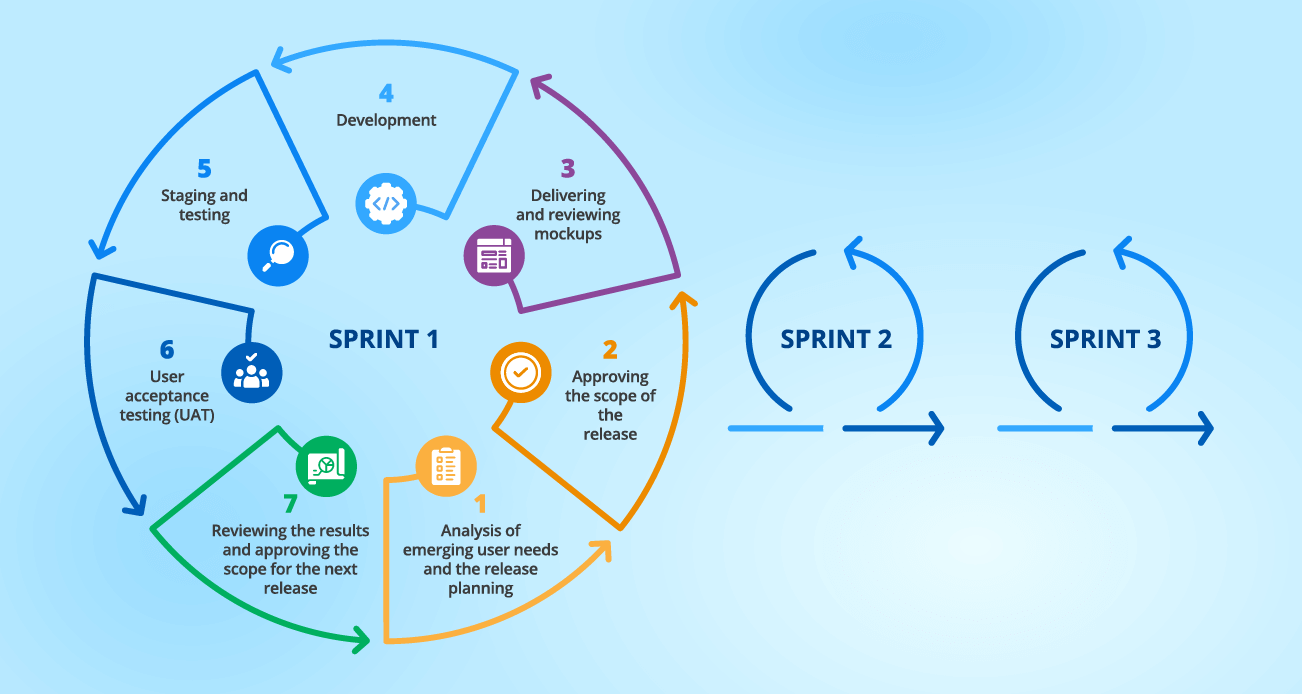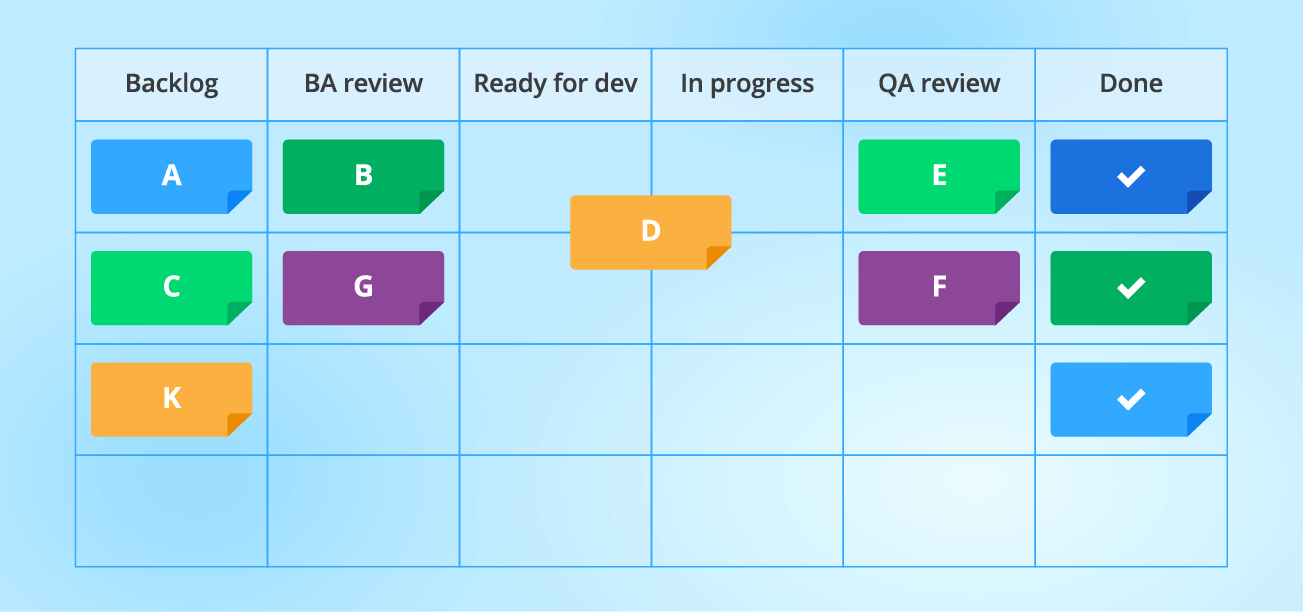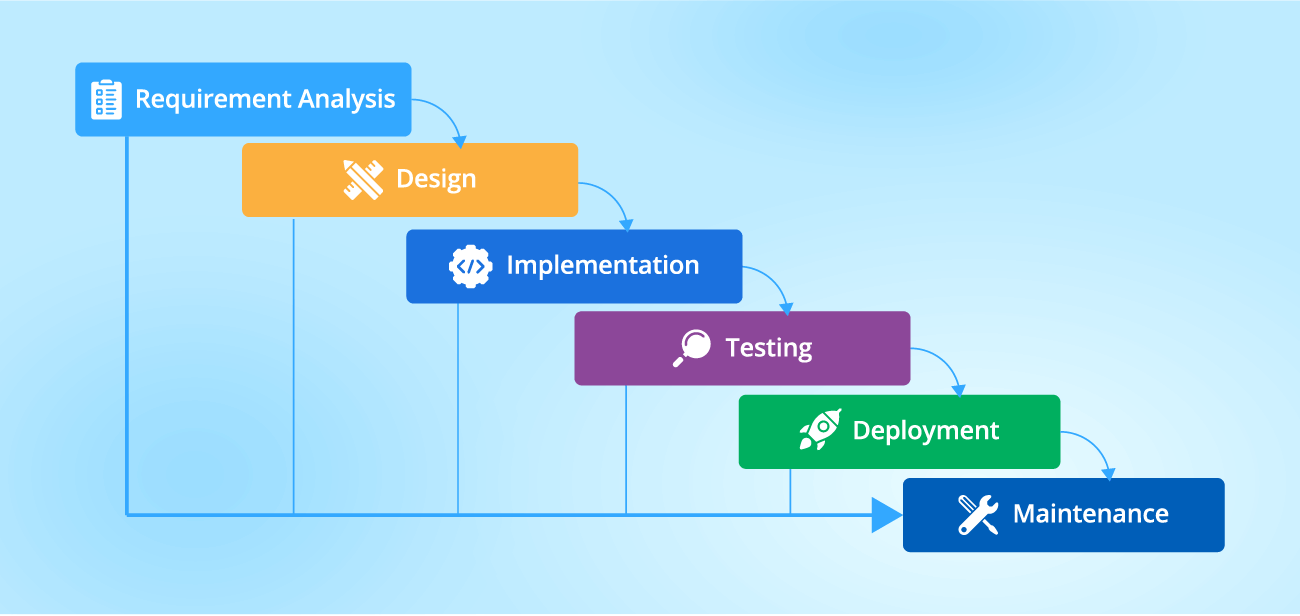We combine deep multi-domain expertise, client-centric thinking, and an innovative approach to design and plan reliable solutions that perfectly fit the needs and behavior of their users.
Software Development Services
• Since 1989 in IT, 750+ experts on board.
• 3,600+ success stories.
• Software development for 30+ industries.
• Full-scale project management office.
We Tailor the Service to Startups and Enterprises
For startups
We have a dedicated page describing our service offer for you. Follow the link to learn how we can take your product from idea to launch together.
For enterprises and mature software development companies
You are on the right page. Here, we describe our approach to developing software for internal use and commercial distribution.
Software development services help plan, design, develop, integrate, test, manage and evolve software solutions. Quality-centered and adherent to software development best practices, ScienceSoft provides application development services to startups, software companies, and enterprises across 30+ industries.
ScienceSoft as a Software Development Partner
Our partnerships and awards
Guaranteed service quality
- Quality-first approach based on a mature ISO 9001-certified quality management system.
- ISO 27001-certified security management that relies on comprehensive policies and processes, advanced security technology, and skilled professionals.
- A full-scale PMO able to carry out even the most complex projects.
- A leading outsourcing provider featured on the Global Outsourcing 100 list by IAOP.
We are trusted by global market leaders
How We Help
At ScienceSoft, we are ready to offer end-to-end development that covers everything from business analysis to software delivery and support, help modernize your legacy software, or provide expert advisory at any stage of SDLC.
Software support and maintenance
We ensure the smooth functioning and relevancy of your software via ongoing performance monitoring, proactive optimization, fast issue resolution, delivery of new features and integrations.
Custom software development
We create software with long-term business value – tailored uniquely to your business processes and adjustable to future needs.
Enterprise software development
We build multi-faceted enterprise solutions that easily withstand the highest loads, scale up as your business grows, and flexibly accommodate functional extensions.
Software product development
We create resilient SaaS, mobile, and desktop software products with great UX and drive fast-paced development – MVP launch in 1–4 months and consequent releases every 2–4 weeks.
Cloud application development
We design and deliver scalable, portable, and secure cloud applications and help migrate apps of any complexity from on-premises infrastructures to the cloud.
Legacy software modernization
We redesign and upgrade your existing software to help you get a modern solution at an optimal cost and with minimal disruption to business workflows.
FAQ about Our Software Development Services
I want to outsource my software development project. How do I get started?
At ScienceSoft, the flow typically looks as follows:
- You send us a request (via a live chat, our email, or by phone).
- We schedule an introductory call to dive into your situation and identify value-adding opportunities you can seize.
- You receive a free proposal showcasing the scope of work / technical solution description, deliverables, team composition with a brief explanation of the expected input of each team member, cost estimates, project timelines, risks and our mitigation strategy.
- We sign a development service contract that legally fixes our mutual obligations and rights.
- You can fully trust us to assemble a project team or can individually talk over the competencies and interview the candidates. Once the team is approved, we are ready to kick off!
Can we discuss my project based on a high-level idea only?
Sure. Just describe your idea in simple words – our consultants will help you draw detailed project requirements, turn the idea into a workable solution concept, and quickly assess its technical and economic feasibility.
What industries do you specialize in?
Having practical experience with 30+ industries, we give special attention to healthcare, BFSI, retail, manufacturing, telecoms, energy, transportation, and professional services. Whatever industry you’re focused on, ScienceSoft’s consultants can help you adhere to the region-specific sectoral regulations, such as HIPAA, PCI DSS, SEC, NYDFS, CCPA, GDRP, SAMA, and more.
How much would my development project cost? Can I get a tailored estimate?
From ScienceSoft’s experience, software development project costs may range from $30,000–$150,000+ (building a mobile app of average complexity) to $800,000–$4,000,000 (creating a large-scale system powered with big data and AI).
At ScienceSoft, we provide free ballpark estimates so you can quickly see if our prices match your budget before we start working together.
Can I trust my information's confidentiality with your team?
Sure. We are ready to sign an NDA before an introductory call to legally protect your sensitive data and intellectual property before the cooperation starts. In our projects, we establish secure and well-controlled collaborative environments by combining protective and detective cybersecurity mechanisms with robust physical security measures.
There are no customer data security incidents overshadowing ScienceSoft’s 34-year history.
Who owns the code?
The delivered code is in your sole ownership; we fix the ownership rights in a service contract.
How long does it take for ScienceSoft to process my initial request and start cooperation?
We process your initial request within 24 hours and guarantee cooperation start in 1–3 weeks, depending on the collaboration pace and service scope.
Some Prominent Software We’ve Created
Different Collaboration Scenarios for Your Software Development
We assemble fully managed development teams to implement software projects end to end. Our team takes 100% responsibility for project planning, collaboration, and risk management. You get top-quality software promptly and at a 1.5–2.5x lower cost.
We compose dedicated teams with all necessary competencies to take over particular tasks (e.g., coding, QA, integration). With a high-performing team focused solely on your project, you can efficiently address skill gaps and speed up development.
We ramp up your team with our best talents (from 0.5 to 150+ FTEs): back-end, front-end, and mobile developers, architects, testing engineers, DevOps engineers, data scientists, and more. You get quick and budget-friendly access to the needed skills.
What Cooperation Model Best Fits My Needs?
Answer a few simple questions and learn the most feasible outsourcing option for your case.
Do you want to temporarily ramp up your development team with particular talents to accelerate the project pace?
Do you have in-house managerial competencies to coordinate and supervise the outsourced talents?
Do you plan to involve or already involved another third-party vendor in the development process?
Do you want the vendor to handle certain project aspects (e.g., only back-end engineering, QA, or data science) rather than a complete development scope?
Tell us more about your needs
Please answer at least one question to help us better understand your business objectives.
You can go with team augmentation
Looks like temporary team extension with the required skills is the most feasible option to meet your development needs. Turn to ScienceSoft if you want to quickly ramp up your team with all necessary competencies – we’ll send CVs of our best talents in 24H.
A dedicated team is your best fit
Looks like a dedicated team of domain-specific experts is the most feasible option to meet your development needs. Turn to ScienceSoft for a professional team with all necessary competencies to partially outsource your project – we are ready to start in just 1–2 weeks.
A dedicated team is your best fit
Looks like a dedicated team of domain-specific experts is the most feasible option to meet your development needs. Turn to ScienceSoft for a professional team with all necessary competencies to partially outsource your project – we are ready to start in just 1–2 weeks.
You definitely should consider full outsourcing
Looks like complete project outsourcing is the most feasible option to meet your development needs. Turn to ScienceSoft for a fully managed team of professionals with all necessary competencies to develop your solution end to end – we are ready to start in just 1–2 weeks.
60+ Software Types in Our Portfolio
Along with the deep knowledge of software architecting and coding principles, we have accumulated vast domain experience and understanding of the context that our software operates in.
By business function
By industry specifics
By technology
Software to Support Industry-Specific Processes
We keep an eye on needs, challenges and trends of 30+ industries with our core experience localized in the following areas.
Software for Advanced Business Tasks
We work with all the mainstream technologies to expand the scope of functions the software can perform.
Big data
Scalable software that aggregates and processes huge volumes of data with high velocity.
Artificial intelligence
Software capable of drawing insights and triggering actions based on historical and real-time data processing.
Data science
Software that can find sophisticated patterns in data and continuously learn to deliver more accurate results.
Internet of Things
Software that allows for fast processing and mining of data captured by physical objects.
Computer vision
Software to recognize patterns and classify objects in digital images and videos.
Augmented reality
Software capable of laying virtual objects over real surroundings.
Virtual reality
Software that creates fictional environment with 3D objects and realistic acoustics.
Blockchain
Software with decentralized and highly secure data storage enabling direct peer-to-peer transactions.
Costs of Software Development Services at ScienceSoft
The cost of software development services may range from $30,000 to $4,000,000+, depending on service scope, software complexity, technical design patterns, and the chosen sourcing model.
Here are the approximate cost estimations based on ScienceSoft's experience in development projects:
$30,000–$70,000
Developing a mobile app of moderate complexity.
~$150,000
Building a native mobile banking or telehealth app.
$150,000–$350,000
Creating a client-facing web platform for the mid-market.
$200,000–$400,000+
Building a specialized automation solution (e.g., for accounting, SCM, ecommerce) of average complexity.
~$800,000–$4,000,000
Implementing a large-scale business automation system powered with big data and AI/ML.
Wondering how much your development project will cost?
Jump to our free cost calculators to quickly learn the budget for your software initiative.
* The estimates provided are not ScienceSoft's official prices for software development projects. We calculate the cost of each project individually based on the customer's specific situation and needs.
Pricing model considerations
An IT vendor’s service pricing model directly impacts the project cost. Knowing this, unscrupulous vendors may attempt to deliberately impose an unfavorable model for larger financial gains.
At ScienceSoft, we never compromise customer trust and offer flexible pricing models depending on the requested service scope and the client’s budget limitations. We avoid confining our clients to one option and can combine several pricing models to reduce development costs. Our team provides a clear rationale behind the choice of particular models to ensure charging on a fair, transparent, and predictable basis.
Check Out Our Software Development Steps
1
Planning
It takes from 2 weeks to:
- Document key business processes and how they’re covered with existing software.
- Elicit business needs and concerns.
- Evaluate risks of new software introduction, e.g., impact on business processes, and plan risk mitigation measures.
- Draw up high-level functional and technical software requirements.
- Prepare the list of software features and integrations.
- Draw up a project roadmap and major milestones.
For commercial software products, it additionally takes from 3 weeks to:
- Conduct competition analysis (competitors’ product features, pricing & monetization models, customer feedback analysis, customer acquisition strategy analysis, product efficiencies and drawbacks).
- Analyze the needs and wants of the target audience and create a product concept.
- Define product differentiation and formulate a unique selling proposition for a product to stand out from the competition.
- Describe obstacles that can hinder entering a given market or industry sectors (including regulatory barriers) and decide how to address them.
2
Business case composition
It takes from 1 week to conduct cost-benefit analysis, estimate NVP, ROI.
3
Architecture, UX and UI design
It takes from 2 weeks to 3 months to:
- Define app architecture, techs, data flow and integration points.
Note: If possible, ScienceSoft will re-use parts of your existing enterprise systems rather than develop new software modules, for lower cost and higher reliability of your software.
- Conduct UX research, outline personas and key user scenarios, prepare user journey maps.
- Create wireframes and clickable prototypes.
- Conduct visual identity analysis, prepare design concept, create a branded UI kit with ready-to-use components (icons, buttons, colors, fonts, etc.), animations, specifications and assets for developers.
Note: We recommend investing in the unique, sophisticated UI design only if the design is a competitive product advantage. Otherwise, we use simple themes and focus on software functionality.
4
MVP launch (upon request)
The delivery of the first working version of enterprise software takes from 1 month. The first working version of software product can be delivered in ~ 2 months.
5
Development and testing
- Agile delivery of new software parts in 2-week releases. Continuous safe minor releases via automated CI/CD pipelines.
- Analysis of emerging needs and the release planning.
- Approving the release scope.
- Delivering and reviewing mockups.
- Developing and testing the approved software part, migrating the developed software part to the staging and production environment.
- Getting feedback from a project sponsor and users on the results of the release.
- Reviewing the results of the completed release and approving the scope of the next release.
Note: Small, well-defined projects can be delivered in a linear mode with one major release.
6
Deployment (and 3-month maintenance)
- Conducting user acceptance testing (UAT).
- Establishing software monitoring processes.
- Defining new roles and responsibilities for application support in your and our teams.
Note: ScienceSoft recommends trial implementation for a limited number of users to minimize possible downtimes in production. Trial stages usually take up to 1-3 months.
7
Project handover / continuous support (on demand)
- Conducting project evaluation.
- Performing knowledge transfer to your in-house IT team/other vendors.
- Providing the final report and requesting your confirmation for the project closure.
Our Practices to Ensure Successful Project Delivery
ScienceSoft’s teams ensure that project goals are achieved, costs and time are predictable, and uncertainties are addressed agilely. You are welcome to check the descriptions of our project management and development practices supported by samples from our real-life projects. We also overview the dirty market practices and traps to avoid.
If you wonder how our approach will work in your case, want to see a project similar to yours, or have any other questions about your initiative, feel free to contact our consultants.
Check the controls behind our ISO 9001-certified management system and explore software quality and project health KPIs we use. We also describe quality controls specific to each SDLC stage.
Discover our requirements engineering, feasibility assessment, and scope mapping practices. The page also explains our approach to Agile scope change management and scope creep control.
Explore our approach to composing an optimal development team and understand the difference in resource assignment processes for full outsourcing and team augmentation models.
Learn the factors ScienceSoft’s teams consider to estimate costs and check our sample top-down and bottom-up estimates. The page also outlines our cost optimization best practices.
Get an idea of strategic and tactical communication forms we rely on throughout the SDLC. The page shows our collaboration toolkit and a sample RACI-based collaboration model.
Visit the page to understand major software development risk factors and explore our risk control and mitigation activities across various SDLC stages.
Explore ScienceSoft’s change request management process from submission to implementation and learn our practices to effectively handle changes.
Check our software documentation best practices and see examples of documents we deliver across various development stages.
Explore metrics we use to evaluate cooperation efficiency, our progress reporting tools, and sample project reports.
Check what is usually covered and what is not covered by our after-launch software warranty and learn its typical period.
Reliable Techs & Tools We Are Proficient In
Choosing an Optimal Pace for Your Project
Scrum development
Software development is done in Sprints, 2–3-week iterations with identified granular goals and backlogs. We ensure process transparency via sprint planning meetings, daily stand-ups, sprint review (and demo), retrospective, backlog refinement (grooming).
Kanban development
The work is done in very short Sprints, often daily. Meetings are held daily or once in 2 days to follow the progress and prioritize next steps. We use the Kanban Board for a clear representation of all project activities, responsible persons, and progress.
Waterfall development
Each next chunk of work is done when the previous one is finished and approved by the stakeholders. The approach demands due diligence at the investigation and planning stage to have all requirements and risks covered.
For many projects it makes sense to use a combination of approaches or switch from one to another depending on the project stage. In our practice, the most common scenarios are ‘Waterfall -> Scrum’, ‘Scrum -> Kanban -> Scrum’. Since switching to a new methodology entails new tools and new processes, a pre-switch intro meeting or mini-training should be conducted by the vendor to keep project running effectively from day one.

 Schedule a call
Schedule a call
